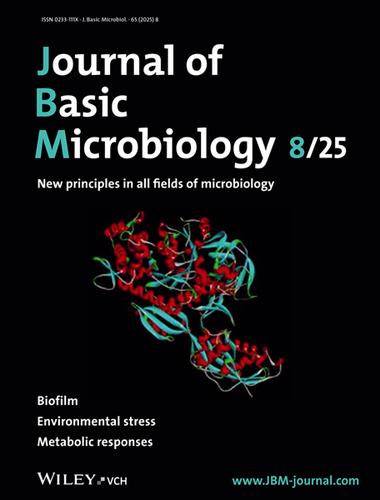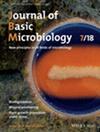Cover: Journal of Basic Microbiology. 8/2025
IF 2.7
4区 生物学
Q2 MICROBIOLOGY
引用次数: 0
Abstract
Cover illustration:
Virus overlay and protein docking assays identified the host TER94 protein as a key binding partner of the IIV6 envelope protein 118L, suggesting its role in viral entry into Spodoptera frugiperda cells. The figure shows the predicted 3D structure of the cellular TEF2 protein, one of the receptor candidates for the viral 118L protein on the host.
(Design: Zihni Demirbag and Cihan Inan, Faculty of Sciences, Karadeniz Technical University, Trabzon, Türkiye)

封面:Journal of Basic Microbiology. 8/2025
封面插图:病毒覆盖和蛋白质对接实验发现,宿主TER94蛋白是IIV6包膜蛋白118L的关键结合伙伴,这表明它在病毒进入frugiperda Spodoptera细胞中的作用。该图显示了预测的细胞TEF2蛋白的3D结构,TEF2蛋白是宿主上病毒118L蛋白的候选受体之一。(设计:Zihni Demirbag和Cihan Inan, Karadeniz技术大学理学院,Trabzon,俄罗斯)
本文章由计算机程序翻译,如有差异,请以英文原文为准。
求助全文
约1分钟内获得全文
求助全文
来源期刊

Journal of Basic Microbiology
生物-微生物学
CiteScore
6.10
自引率
0.00%
发文量
134
审稿时长
1.8 months
期刊介绍:
The Journal of Basic Microbiology (JBM) publishes primary research papers on both procaryotic and eucaryotic microorganisms, including bacteria, archaea, fungi, algae, protozoans, phages, viruses, viroids and prions.
Papers published deal with:
microbial interactions (pathogenic, mutualistic, environmental),
ecology,
physiology,
genetics and cell biology/development,
new methodologies, i.e., new imaging technologies (e.g. video-fluorescence microscopy, modern TEM applications)
novel molecular biology methods (e.g. PCR-based gene targeting or cassettes for cloning of GFP constructs).
 求助内容:
求助内容: 应助结果提醒方式:
应助结果提醒方式:


